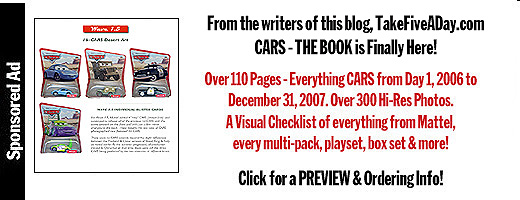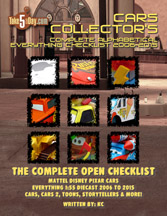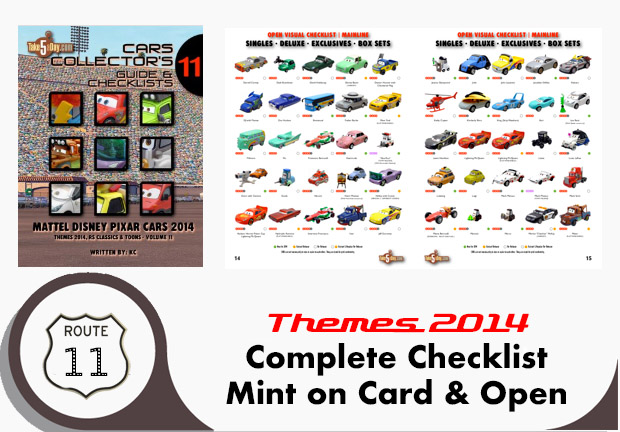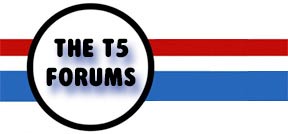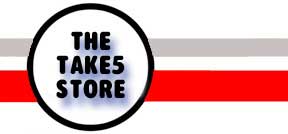Mattel Disney Pixar Diecast CARS: Card & CAR Grading For Buying & Trading
Since it has come to my attention that recent trades have involved CARS & cards are not listed correctly, plus questions about yesterday’s post … here is basic primer on listing-grading your CARS & cards.
EVERYONE judges everything different so there is no definitive guide that will over every detail – this is just a basic primer to get you started and of course, this guide will only apply to the Mattel Disney diecast CARS but you can apply some of the principles here to other toys.
There are only a few items that actually comprise of the package: The car, its holder, the blister, the card, the J-hook and the card itself – of course, some items hold greater value and importance.
There are four basic criterias for judging a CAR on a blister pack are:
QUALITY CONTROL OF THE CAR
QUALITY CONTROL OF THE CAR IN THE PACKAGING
PACKAGING FACTORY HANDLING
PACKAGING RETAIL HANDLING
QUALITY CONTROL of the CAR
This is pretty straightforward. No extraneous paint marks or paint splotches? Tampo decals on straight (if they’re supposed to be straight?) … etc, etc … or are there any obvious errors in assembling this CAR? Which though interestingly enough for some collectors will increase its value if it is an error in assembling the car (and not poor worksmanship) … it depends on how unusual the error might be – wrong wheels? No sticker? Bumper assembled upside down, etc …
QUALITY CONTROL of the CAR in the PACKAGING
Basically, to diminish its value, it is almost always inserted into the blister before the paint has dried which you should notice on the blister that paint has rubbed off or on the CAR itself. This doesn’t happen often but can be a bigger problem during summer with higher humidity at the location of the factory. Other possible reduction in value include the wrong plastic holder so the CAR is jammed into it … or as was the problem earlier this year – there was either no glue or very weak glue so the blister bubble was not adhered to the card. And as noted earlier, that means sometimes they don’t change the cardboard diecut blade so the cut is not as clean … or the card artwork color will vary slightly because of cheaper cardboard that doesn’t hold ink as well or maybe someone cheated someone and subbed in cheaper paint … but sometimes, there’s not much you can do since if you want the CAR right now and you’re unsure when it will be re-released, you just have to buy it now with its “flawed” card …
Separately, when it’s an ERROR in poor quality control in the packing portion, it can be more valuable – wrong nameplate, faced the wrong direction, etc, etc …
PACKAGING Factory Handling Marks
You have to keep in mind, these are mass market items so they are packed in an assembly line in a pun intended, blistering pace … the plastic blister bubble will rub against each other before and after assembly … cards are separately by a cutting blade so there will be a separation mark, they apply pressure after the glue is applied to make a seal so sometimes, they will press an indentation into the other side of the card and the packaging will rub against each other from the factory door to the docks to a month long sea voyage (in most cases) and then a long trip by plane, train or truck across the US (or your country). So, even BEFORE it leaves the factory, there are generally already handling rubs and packaging marks if you look closely enough. Again, this is an expected part of toy-diecast collecting. You don’t want obvious marks but it’s virtually impossible to find a card that leaves at the factory perfect in every aspect … it all depends on how closely you look … and then a 5,000 mile journal to you in a box will just adds to it
PACKAGING Retail Handling Marks
Commonly referred to shelf rub, handling marks plus “wear & tear” – especially for a hanging card that hangs on the shelf for a while. The clerk opens the box, flexes the j-hook up and hangs it – now – a few or hundreds of people will touch that card or knock it off looking for the CAR behind it … etc, etc, etc …the most obvious thing is that corners get dinged and the front plastic blister gets shelf rub marks … but it’s not always from retail as CARS are packed faced to face though there is a sheet of tissue – of course, that sheet of tissue is not exactly Egyptian cotton … more like port-o-potty toilet paper so the sheet itself could be causing extra marks 🙂 … also in the case of CARS, now with the new lighter weight card – plus the easier to dent corner design to begin with, yo can’t blame retail 100% of the time.
Though let’s look at two random cards, these two HANK ‘Halloween’ Murphy’s. This CAR has no obvious quality production errors and the card is pretty much perfect. There are no bent or dinged corners and there are no obvious marks on the front blister. While I’m not sure you could rank this a 100% grade, you would certainly say this for CARS, it’s probably in the top 10% of cards.
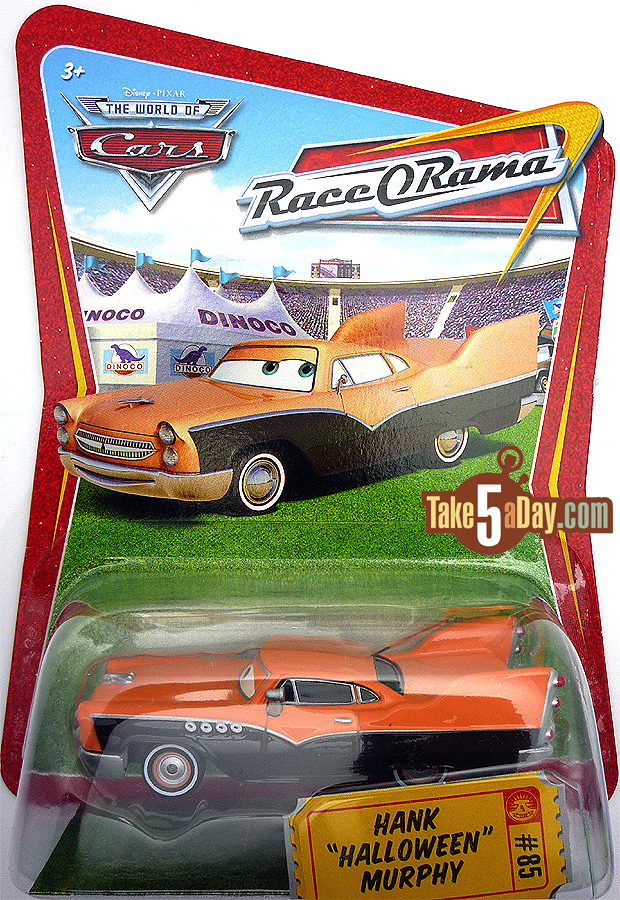
Conversely, another Hank ‘Halloween’ Murphy might be closer to what you might typically find at retail.
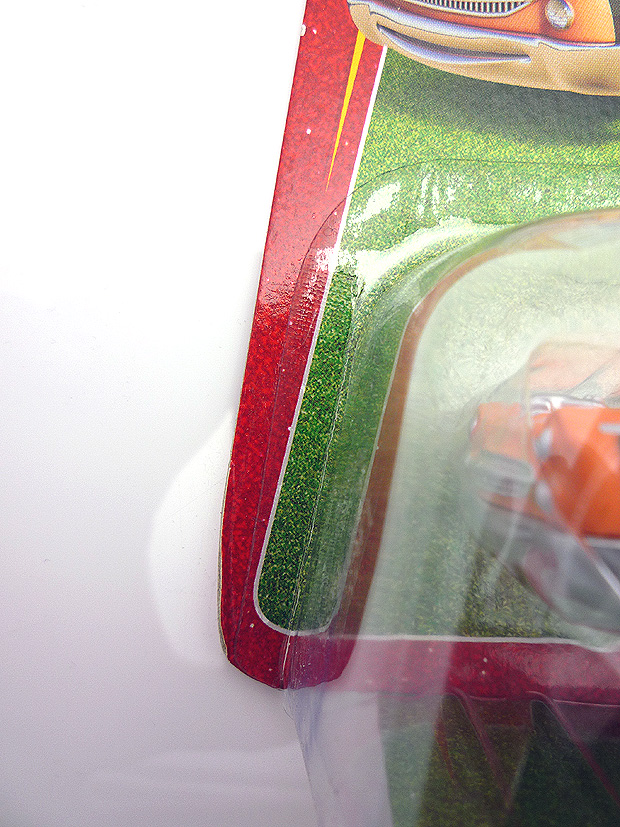
Left side of card has typical “ding” or “soft” corner – again, probably already this way from the factory with the new lighter weight cardboard … and you’ll notice that to left of his “mouth,” there is a tiny mark – probably also from the factory when this card was separated from the giant cardboard sheet and the tearing into this card took off a tiny chunk of the front of the art of this card.
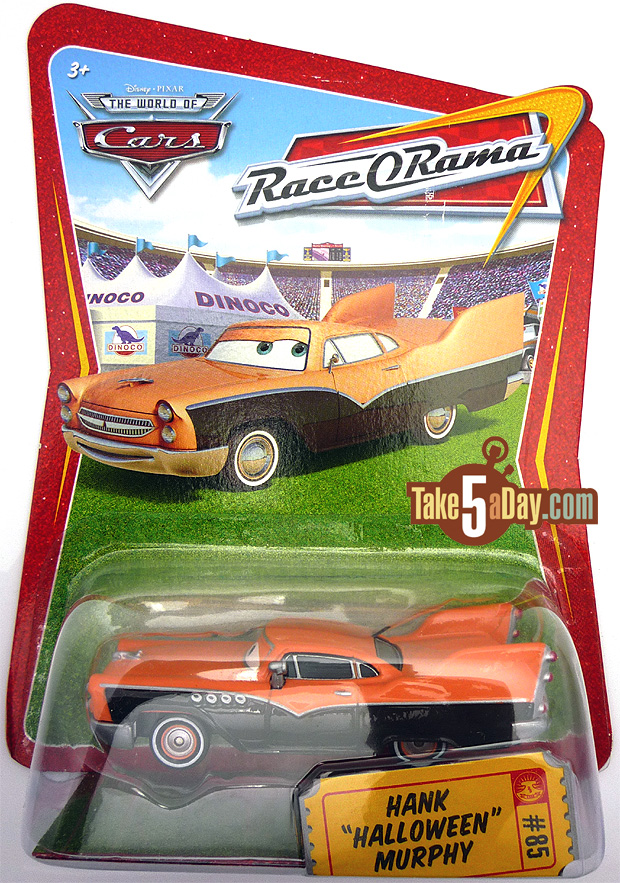
Now, the CAR itself seems to be fine … but you can also see some minor marks under the RAMA and the top middle of the card – presumably when they pressed the back J-card onto this card, the clamp mechanism took off some of the top layer of the artwork on the front of the card. If you’re an opener, no biggie as the CAR seems to be all normal … but for most collectors, this card has a few too many marks …
BUT it is totally subjective … because for instance, if the card only had the left side ding, it would be considered a “normal” condition card for 98% of collectors but for 2%, it would be totally unacceptable …
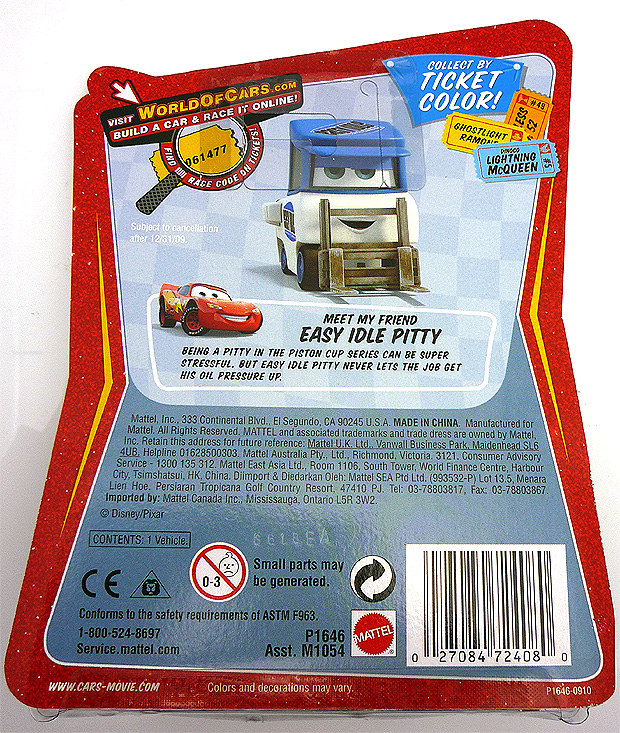
In this case, the j-hook is down – important for some but in the normal scheme of “grading,” not a major consideration – nice that it’s never been lifted but understandable that a retail item would have the j-hook lifted up …
And also to note, for instance, the blister bubble (see bottom) is clearly applied slightly off but as it’s done at the factory and within the range of acceptable parameters … should it be noted in a sale or auction as “not the best job the factory could’ve done?” Again, totally subjective and within the normal parameters as part of the normal course for most people …
So, what’s right and what’s not right in how to list or sell?
Let’s start with the obvious.
Your CAR can only be FACTORY SEALED or it is not
There is no middle ground. Even if the factory glue failed, do not resealed it yourself – point this out or return it to the store. It is either 100% FACTORY SEALED or its not. Now, you can also list it as NEW, unopened (without card) and still in it’s blister holder & shell … if you have not touched it, it is NEW but it is NOT factory sealed. And of course, if you have played with it – note that it’s loose and any “un-factory” like conditions (chips, etc, etc …)
NORMAL MINOR PACKING WEAR
This again is subjective but again, most people will find it acceptable that the corner might be a little soft or dinged (BUT NOT bent or with a CREASE). Basically if you hold it about 2 feet away, is it noticeable?, if it’s not, then for 98% of people, that falls under the range of normal & minor packing wear & rub. But if there is a crease or as with the second Hank card above – with definite white areas where the art has lifted off, you have to note that … if they are openers, they will not really care but you want to tell them that anyway.
CAR Production Quality
Again, in 99% of cases, the CAR should look fine without any glaring problems and you are not expected to be able to see any potential problems on the dark side of the CAR & card. And you have to list or warn people of any additional marks or obvious areas of deficiency … of course, you won’t get top dollar but some people might be willing to buy a flawed CAR as the opener for their 2-year old to play with so it’s still worth something and everyone knows what they are buying.
For Collectors?
Basically your highest value is to keep it sealed and mint.* And again, the highest value is to grade the 4 points outlined at the very top.
CAR itself looks correct – no obvious paint flaws, no decal problems nor errors.
Packaging intact without extraneous marks? Blister plastic bright & ‘shiny”? No major or obvious shelf or shipping rubs? No addition or subtractions to the original packaging … no extra price stickers, NO pinholes (unless original from factory) and j-hook still attached …
And yes, that brings up the point of the recent “repair” jobs that Mattel did to strengthen the glue on the packaging, mainly by adding 3-6 round clear stickers. Sorry, they subtract from heir collectibility … if Mattel was smart, they would’ve printed up stickers saying something with their old tagline, If It’s Mattel, It’s Swell or something but instead were hoping no one would notice – so detract value from “stickered” CARS … even authorized stickers.
Card with the fewest handling marks is better. Some marks always expected but the less obvious the better, no creases or folds … no fingerprints, no major fraying or UV-like Sun damage to artwork (fading, etc…).
* That’s NOT to say that any or loose CARS are not still worth a monetary return. The most obvious example is Sarge but unlike some other diecast lines, loose is still worth something – as long as keep them chip-free and they are probably more valuable packaged together …
And related, while you can’t really re-assemble the singles – box sets that are opened can be reassembled and noted as such is still worth something …
Summary
As a mass market item – not packaged in a metal box and in a card design easy to ding, very few people expect perfection for every card and every CAR and will accept some minor flaws from the factory or from normal handling. Though every person selling or buying has a different criteria on what is acceptable, normal or what is not – so the more information you provide – whether buying or selling – will make your transaction more satisfactory to everyone involved.
Good luck and happy hunting!
| « Mattel Disney Pixar Diecast CARS: Elvis RV – LIVE in Australia! | Mattel Disney Pixar Diecast CARS: Samurai60 Pay it Forward Update » |
